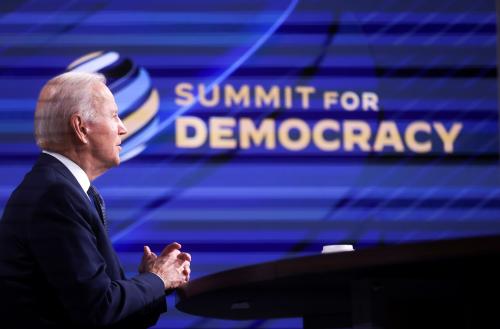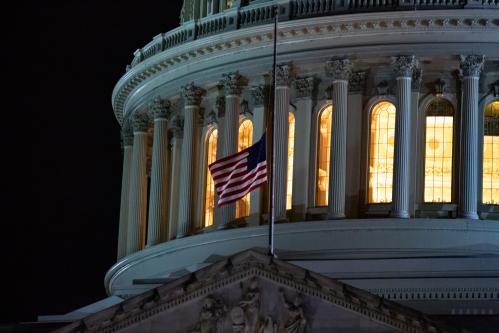On February 14, 2022, two months after the first Summit for Democracy, the U.S. Department of State released written commitments from 56 governments focused on strengthening democracy, combatting corruption, and defending human rights. Now the post-summit Year of Action can begin in earnest. As two of us discussed in a post right after the Summit, for the event to achieve its objectives, civil society, the private sector, and other good governance champions must work with and hold governments accountable for the implementation of concrete, measurable, and meaningful commitments.
From our initial survey, we observe significant variation in terms of the specificity and nature of commitments published thus far. Here, we offer a brief snapshot of the distribution of countries with published commitments, the range of those commitments, and their significance.[1] Our initial reactions are preliminary; this post offers a roadmap for the deeper reading and analysis of the commitments that we and many others will undertake.
The countries that have submitted written commitments to date fall along the spectrum of governance regimes, as defined by the recently released Democracy Index 2021 from the Economist Intelligence Unit. [2] 53 of 167 countries featured in the index provided written commitments with clear over-representation of those classified as full democracies—18 out of 21 full democracies submitted commitments.[3] Meanwhile, 26 out of 53 countries considered flawed democracies submitted commitments. An even smaller group of hybrid regimes (that is, ones that combine democratic and autocratic features; 8 out of 34 countries) and a minuscule proportion of countries under what are considered authoritarian regimes (1 out of 59 countries) responded to the call for written commitments.
Among these submissions, the nature of the commitments varies. Most countries offer some commitments on the domestic front, but many, particularly the full democracies, focus on the international arena. As examples, the Democratic Republic of the Congo’s commitments include “organizing elections within constitutional deadlines,” while New Zealand’s include a pledge of “1 million NZD to support anti-corruption within the Pacific region.”
Some countries made highly specific commitments, while others shared only broad objectives or a declaration of intentions. While not the sole indicator of a commitment’s robustness, specific information such as measurable outputs and the relevant actors, resources, and mechanisms needed for implementation is valuable. This information better enables other participating governments, civil society, and other good governance champions to assess the extent of progress toward stated goals—and help hold governments accountable to meeting them.
We can look to the Summit’s host, the United States, for an example of commitments that reference specific elements such as relevant actors and resources. For instance, to help advance the new U.S. anti-corruption strategy, the State Department, collaborating with the Departments of Treasury and Justice, will “provide up to $15.1 million to launch the Democracies Against Safe Havens Initiative, which will work to build the capacity of partner governments to deny corrupt actors the ability to hide ill-gotten gains through anti-money laundering measures, to encourage like-minded partners to adopt anti-corruption sanctions and visa restriction regimes, and to detect and disrupt complex corruption schemes.”
Even for the more robust commitments, multiple factors may limit their impact. We will need to evaluate the commitments in terms of these possible obstacles so they can be addressed and overcome. For example, as our Leveraging Transparency to Reduce Corruption team has noted in our TAP-Plus framework, the implementation of initiatives is conditioned by different dimensions of context.[4] Commitments are subject to the enabling or constraining governance ecosystem in which they are made. For example, promoting a new law to advance good governance does not mean that the law will pass, as political dynamics or other factors may impede it, or that such a law will actually achieve its intended goal in terms of anti-corruption, expansion of rights, or human rights protection (as other legislation may limit its impact or weaken its enforcement).
To put an even sharper point on it, the credibility and effectiveness of commitments may be eroded by disconnects between them and the existing governance conditions. Without meaningful reform and engagement with civil society, commitments—particularly those made in challenging governance contexts such as environments with limited media freedom, constrained civic space, and low political trust—will remain, at best, aspirational. We discuss these and other contextual factors that enable or constrain the success of efforts to advance democracy and reduce corruption in our TAP-Plus report. We will use that framework, among others, as we consider the deeper analysis that these commitments merit.
While the commitments (like the process of developing them) are sure to feature imperfections, they represent a starting point for debate and further development. They must be studied, gaps and opportunities identified, and implementation and supplementation undertaken. Independent analysis is critical for assessing whether commitments address key governance challenges and support the objectives of advancing democracy, defending human rights, and combating corruption.
Promoting inclusive dialogue and debate within and between countries, civil society, and other stakeholders will be essential to fulfill the objectives of the Summit. The Open Government Partnership (OGP) is one such platform for engagement. Mechanisms like OGP—with domestic action plans, accountability mechanisms, and space for dialogue—will be important for ensuring follow-through, as will efforts of all concerned at the local, national, and global levels to advance accountability.
Nor should we look only to 2022 and the follow-up Summit planned for its conclusion. For meaningful progress to be made, we must consider the longer time horizon in which commitments unfold. The Year of Action must be turned into years of action. To support these efforts, we look forward to actively participating with others in the work of discussing, monitoring, and analyzing the commitments and their implementation with a particular focus on anti-corruption efforts at the country and international levels. We are at an inflection point in combating corruption and advancing democracy, and together we can seize it. The stakes could not be higher.
The authors thank Matthew Eitel for fact-checking and copyediting assistance.
Footnotes
[1] As noted on the Summit for Democracy’s written commitments page, the list of 56 countries “reflects those that submitted commitments in writing; if a hyperlink is missing that means the commitments are still undergoing a mandatory accessibility compliance review. […] Additional commitments will be processed as received from delegations and posted online.” We have described our initial impressions of the written commitments available as of February 14, 2022.
[2] For the full descriptions of regime types, see page 68 of the Democracy Index 2021 report.
[3] Note that three countries that have submitted written commitments (Samoa, Maldives, and Kosovo) are not included under the Democracy Index ratings.
[4] TAP stands for transparency, accountability, and participation, the traditional trifecta of open governance initiatives.









Commentary
The Summit for Democracy commitments are out—now what?
February 23, 2022